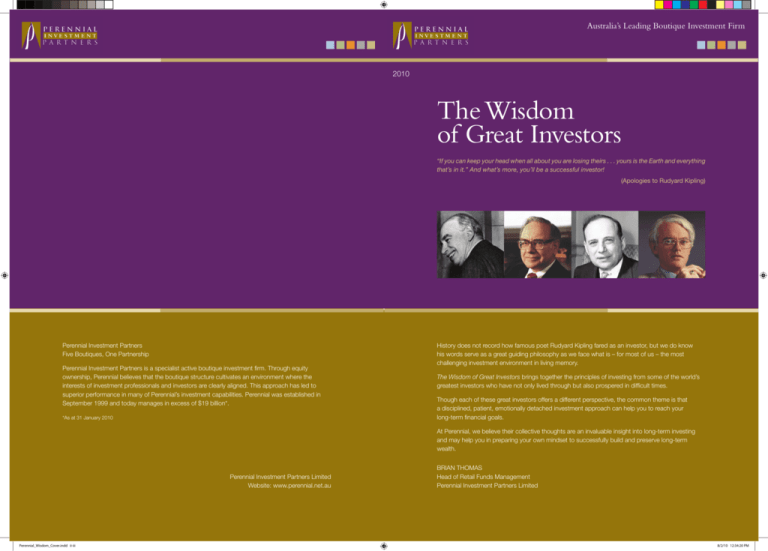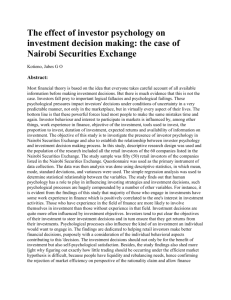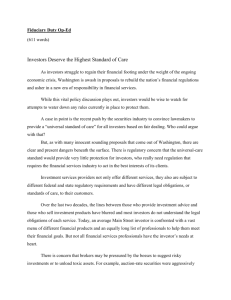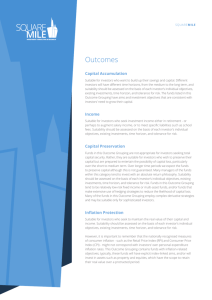The Wisdom of Great Investors
advertisement

Australia’s Leading Boutique Investment Firm 2010 The Wisdom of Great Investors “If you can keep your head when all about you are losing theirs . . . yours is the Earth and everything that’s in it.” And what’s more, you’ll be a successful investor! (Apologies to Rudyard Kipling) Perennial Investment Partners Five Boutiques, One Partnership Perennial Investment Partners is a specialist active boutique investment firm. Through equity ownership, Perennial believes that the boutique structure cultivates an environment where the interests of investment professionals and investors are clearly aligned. This approach has led to superior performance in many of Perennial’s investment capabilities. Perennial was established in September 1999 and today manages in excess of $19 billion*. *As at 31 January 2010 History does not record how famous poet Rudyard Kipling fared as an investor, but we do know his words serve as a great guiding philosophy as we face what is – for most of us – the most challenging investment environment in living memory. The Wisdom of Great Investors brings together the principles of investing from some of the world’s greatest investors who have not only lived through but also prospered in difficult times. Though each of these great investors offers a different perspective, the common theme is that a disciplined, patient, emotionally detached investment approach can help you to reach your long-term financial goals. At Perennial, we believe their collective thoughts are an invaluable insight into long-term investing and may help you in preparing your own mindset to successfully build and preserve long-term wealth. Perennial Investment Partners Limited Website: www.perennial.net.au Perennial_Wisdom_Cover.indd ii-iii BRIAN THOMAS Head of Retail Funds Management Perennial Investment Partners Limited 8/2/10 12:34:20 PM Table of contents Avoid self destructive behaviour 1 Don’t attempt to time the market 2 Be patient 3 Don’t let emotions guide your investment decisions 4 Recognise that short-term underperformance is inevitable 5 Spread your investments between and within 6 Disregard short-term forecasts and predictions 7 Summary 8 Some of this document has been reproduced with the kind permission of US Investment Manager Davis Advisors (davisfunds.com). Perennial gratefully acknowledges their assistance in bringing some of their insights to Australian investors. Photographs of Jesse Livermore and John Maynard Keynes were sourced from Wikipedia Commons. Perennial_Wisdom.indd ii 8/2/10 1:29:05 PM Avoid self destructive behaviour “Individuals who cannot master their emotions are ill-suited to profit from the investment process.” Benjamin Graham,1 father of value investing E MOTIONS can wreak havoc on an investor’s ability to build long-term wealth. This is illustrated in Chart 1, below. Over the 20 year period from 1988 to 2007, the average US managed fund returned 11.6% p.a. If we look at the actual return the average investor received when you take into account their timing into and out of the funds, it comes as a surprise to learn that the average managed fund investor earned only 4.5% p.a. over the same period. Question: Answer: Why did investors miss out on nearly two-thirds of their potential return over this period? They let emotions guide their investment decisions. Perhaps driven by powerful emotions like fear and greed, many of these US investors engaged in behaviour contrary to their long-term investment strategies and as a result missed out on nearly two-thirds of the potential return over this period. This behaviour includes chasing the “hot” manager or asset class, avoiding areas of the market that are out of favour, attempting to time the market, or otherwise abandoning investment strategies. US investors are not unique; investors in Australia and around the world can be prone to the same pitfalls. The most successful investors understand that building long-term wealth requires the ability to control one’s emotions. They tend to buy low and sell high, as opposed to the emotional investor who does just the opposite. Chart 1: Average US Stock Fund Return versus Average US Stock Fund Investor Return (1988–2007) !VERAGE!NNUAL2ETURN 4HEhINVESTOR BEHAVIOURv PENALTY !VERAGE533TOCK &UND2ETURN !VERAGE533TOCK &UND)NVESTOR2ETURN Source: Quantitative Analysis of Investor Behaviour by Dalbar, Inc. (July 2008) and Lipper. Dalbar computed the “average stock fund investor” returns by using industry cash flow reports from the Investment Company Institute. The “average stock fund return” figures represent the average return for all funds listed in Lipper’s U.S. Diversified Equity fund classification model. Dalbar also measured the behaviour of a “systematic investor” and “asset allocation investor”. The annualised return for these investor types was 5.8% and 3.5% respectively over the time frame measured. All Dalbar returns were computed using the S&P 500® Index. Returns assume reinvestment of dividends and capital gain distributions. Past performance is not a guarantee of future results. 1 Benjamin Graham (1894–1976) is considered to be the father of value investing, an approach he taught at Columbia Business School and later refined with David Dodd during the many editions of their famous book Security Analysis. 1 Perennial_Wisdom.indd 1 8/2/10 1:29:07 PM Don’t attempt to time the market “Far more money has been lost by investors preparing for corrections or trying to anticipate corrections than has been lost in the corrections themselves.” Peter Lynch,2 legendary investor and author A VOLATILE market can cause investors to panic and to abandon long-term investment strategies by pulling out of the sharemarket, with the intention of moving back in when the environment improves. It is almost impossible to predict when markets will improve and, by attempting to do so, investors lose out on the returns they could have earned had they stayed put. Chart 2 illustrates the danger of trying to time the market. Over the 20 years to 2009, the investor who missed only the best 10 trading days, out of the 5,240 trading days in this period, saw their return reduce to 7.4%. Amazingly, an investor only had to miss the best 60 days to see their return turn negative! Looking at Chart 2, it would appear that the most successful investors are those who understand that timing the market is almost impossible and stick with their long-term strategies. Chart 2: The Danger of Trying to Time the Market (All Ordinaries 20 Year Average Annual Returns 1989–2009) 9EAR#OMPOUND2ETURN n n n n n 3TAYEDTHE #OURSE -ISSED"EST $AYS -ISSED"EST $AYS -ISSED"EST $AYS -ISSED"EST $AYS Source: All Ordinaries, Perennial Investment Partners, IRESS to 31 December 2009. 2 Peter Lynch (born 1944), a Wall Street investor, was hired by Fidelity as an Intern in 1966. In 1977, Lynch became head of the Magellan Fund, which had $18 million in assets. By the time of his retirement in 1990, the fund had to grown to in excess of $14 billion in assets. Peter Lynch has co-written three books on investing, including One Up on Wall Street, Beating the Street, and Learn to Earn. His most famous investment principle is “Invest in what you know”. 2 Perennial_Wisdom.indd 2 8/2/10 1:29:07 PM Be patient “The market does not beat them. They beat themselves, because though they have brains they cannot sit tight.” Jesse Livermore3 P ATIENCE is a common attribute among great equity investors. In our view, the ability to be patient and take a long-term view is important because, while equities have historically delivered growth in excess of all the other major asset classes, in the short-term the value of a company’s shares may be susceptible to sentiment and irrational buying and selling. Over the longer-term, the true underlying value of a company is likely to be acknowledged by the wider market, benefiting those investors who stuck with it. Chart 3 and Chart 4 show how the volatility of returns decreases when viewed over a longer-term timeframe. Chart 3: Rolling one year returns (IGHEST2ETURN ,OWEST2ETURNn n *UL *AN *UL *AN *UL *AN *UL *AN *UL *AN *UL *AN *UL *AN *UL *AN *UL *AN *UL *AN *UL *AN *UL *AN *UL *AN *UL *AN *UL *AN *UL *AN *UL *AN *UL *AN *UL *AN *UL *AN *UL *AN *UL *AN *UL *AN n *AN n Chart 4: Rolling seven year returns p.a. (IGHEST2ETURN ,OWEST2ETURN *UL *AN *UL *AN *UL *AN *UL *AN *UL *AN *UL *AN *UL *AN *UL *AN *UL *AN *UL *AN *UL *AN *UL *AN *UL *AN *UL *AN *UL *AN *UL *AN *UL *AN *UL *AN *UL *AN *UL *AN *UL *AN *UL *AN *AN *UL *AN Source: All Ordinaries as at 31 January 2010. The knowledge that stocks have historically rewarded long-term patient investors may help you to achieve your long-term investment goals. 3 Jesse Livermore (1877–1940) was a trader in the 20th century. He is famous for making, losing and then making several millions of dollars and for short selling during the stock market crashes in 1907 and 1929. Jesse Livermore wrote How to trade in stocks; the Livermore formula for combining time element and price. The book was published in 1940, coincidently the year he committed suicide. 3 Perennial_Wisdom.indd 3 8/2/10 1:29:08 PM Don’t let emotions guide your investment decisions “Be fearful when others are greedy. Be greedy when others are fearful.” Warren Buffett,4 Chairman, Berkshire Hathaway B UILDING long-term wealth often requires counter-emotional investment decisions, such as buying at times of maximum pessimism or resisting the euphoria around investments that have recently outperformed. Unfortunately, as Chart 5 shows, investors too often let emotions guide their investment decisions. This translates to buying when prices are high and panic selling when prices fall. Following three years of stellar returns from 1997–1999, in 2000 US investors invested record amounts into managed funds, just in time to experience three years of negative performance. On the heels of these three terrible years, sentiment turned pessimistic and net inflows into managed funds dropped right off, just before managed funds delivered one of their best ever returns of 29.7%. 2008 saw a similar reaction from investors gripped by fear, with managed fund inflows drying up completely and huge outflows as shown in Chart 5. Judging from Chart 5 it would appear that great investors recognise that an objective, disciplined, emotionally detached investment approach, which may include buying at times of maximum pessimism, can be key to building long-term wealth. Chart 5 -UTUAL&UND.ETFLOWIN53! 30)NDEX 53$"ILLIONS n n !REPEATOF )NVESTORSCASHED INATPRECISELYTHE WRONGTIME n n Source: Bloomberg and ICI as at 31 December 2009. 4 Warren Buffett (born 1930) is one of the worlds most successful investors and businessmen, and is one of the world’s richest men, with an estimated net worth of $62.0 billion. 4 Perennial_Wisdom.indd 4 8/2/10 1:29:09 PM Recognise that short-term underperformance is inevitable “The social object of skilled investment should be to defeat the dark forces of time and ignorance which envelope our future.” John Maynard Keynes,5 economist I T CAN BE hard to take a long-term view when there is so much up to the second data available with regard to your investments. Paying too much attention to daily or weekly performance charts can not only be bad for your health, but also bad for your wealth. When faced with short-term underperformance from a fund manager, some investors lose conviction and switch to another manager. When evaluating fund managers, short-term performance is generally not a strong indicator of long-term success. Comparing a fund manager against its peers over different periods, encompassing different stages of the investment cycle, should stand investors in good stead when evaluating performance. An Australian study surveyed6 the 112 best performing large-cap equity funds with a 10 year track record. The study looked at which funds were most consistently in the first or second quartile in the period 1998–2007. The study then went on to look at how many of these top fund managers had suffered a period of sustained underperformance over the same period. The results were staggering. Of the top 10 managers: 90% of these top managers’ rankings fell to the bottom half over this period for at least one year, whilst 40% of these top rated mangers rankings fell into the bottom quartile over this period for at least one year. Chart 6: Percentage of large cap equity managers whose performance fell into the bottom half or quartile for at least a one-year period. "OTTOM(ALF "OTTOM1UARTILE Why is this the case? Investment managers who achieve good long-term results typically follow a rigorous and consistent process. There will invariably be times when their particular approach (or investment style) will not produce the best results in the short-term. Due to this, many investors try to combine managers with different approaches (e.g. value and growth styles), in order to maximise the consistency of their returns during different stages of the investment cycle. In summary, even though the managers in the study delivered the best overall long-term returns, almost all suffered at least one difficult period. Investors who recognise this possibility and prepare for the fact that short-term underperformance is inevitable, even from the best managers, may be less likely to make unnecessary and often harmful changes to their investment plans. 5 John Maynard Keynes (1883–1946) was an economist whose ideas called, Keynsian Economics, still influence Keynes advocated interventionist government policies and is considered one of the most influential economists of all time. 6 Morningstar “The Most Consistent Large-Cap Share Funds” by Phillip Gray 21/05/2008. 5 Perennial_Wisdom.indd 5 8/2/10 1:29:10 PM Spread your investments between and within “When all is said and done, there is really only debt, equity and property in which to invest. It’s the combination of asset classes and the blends within each asset class that determines the success of a portfolio over the long-term.” Mike Crivelli,7 Founder and Chairman of Perennial Investment Partners Limited W HEN US energy trading firm Enron went bankrupt in 2002, it was shocking to learn that many of the staff had all of their finances tied up with the firm. Employees of Enron had their superannuation funds and their entire non-superannuation wealth invested in Enron shares. Some Enron staff lost not only their jobs, but their investments AND superannuation too – a classic example of putting all your eggs in one basket. We believe the key to portfolio investing is to invest between different asset classes (shares, property, fixed interest, cash etc), preferably ones that complement each other in that they are negatively correlated and therefore likely to perform differently across future scenarios. In addition, risk can be further reduced and returns enhanced by ensuring a range of securities are held within each asset class. Managed funds are a way to achieve diversification through one investment transaction. Perhaps the best example of diversification between asset classes is to look at how Australian fixed interest performs at times when the Australian sharemarket is weak, as shown in the Table 1 below. As you can see from Table 1, including some fixed interest in your portfolio could help to protect you when equity markets are struggling. Table 1 Period % return Australian Shares Australian Fixed Interest 5 months to 28 February 1988 –43.5 5.1 5 months to 31 December 1990 –16.2 9.9 5 months to 31 October 1992 –14.5 4.2 3 months to 30 September 2001 –12.0 4.3 9 months to 28 February 2003 –14.0 9.3 15 months to 28 February 2009 –48.3 15.5 Source: All Ordinaries Index, UBS Composite Bond Index/SBC Warburg Composite Bond Index, Perennial Investment Partners Limited. 7 Mike Crivelli (born 1939) is one of the most experienced and highly regarded investment professionals in Australia. He is the Executive Chairman of Perennial Investment Partners, which he founded in 1999. Mike has nearly 40 years experience in funds management, of which 22 years were with BT Fund Management Limited. Mike was one of Bankers Trust Australia Limited’s founding team. Mike has held a number of Directorships including BT Australia, State Super Financial Services Ltd, Colonial Agricultural Ltd, Barnardos, TIF (the investment management arm of the TWU) and Statewide Roads Ltd. Mike is currently chairman of a number of Perennial operating companies. 6 Perennial_Wisdom.indd 6 8/2/10 1:29:10 PM Disregard short-term forecasts and predictions “The function of economic forecasting is to make astrology look respectable.” John Kenneth Galbraith,8 economist and author D URING periods of uncertainty, investors often gravitate to the investment media for insights into how to position their portfolios. Media portrayal can often exaggerate and sensationalise current events, increasing investors’ concerns. However compelling the forecasts and views of the media may appear, it often adds little value to an investor’s decision making process. The study below tracked the average interest rate forecast from The Wall Street Journal Survey of Economists from December 1982–June 2008. This forecast was then compared to the actual direction of interest rates. Overall, the economists’ forecasts were wrong in 35 of the 52 time periods – 67% of the time! Table 2 suggests that investors should not spend time and energy focusing on variables that are unknowable and uncontrollable, like the direction of interest rates or the value of the All Ordinaries Index. Instead, focus on things that you can control, like creating a well diversified portfolio appropriate for your investment time horizon, taking into account your objectives, needs and financial situation. Table 2: Six Month Average Forecasted Direction vs Actual Direction of Interest Rates The Wall Street Journal Survey of Economists (12/8–6/08) Date Forecast Actual Result Date Forecast Actual 12/82 ▼ 6/83 ▼ 12/83 Result Date Forecast Actual Result ▼ Right 12/91 ▼ ▲ Wrong 6/92 ▼ ▼ Right 12/00 ▲ ▼ Wrong ▲ Wrong 6/01 ▼ ▲ ▼ ▲ Wrong 12/92 Wrong ▼ ▼ Right 12/01 ▼ ▼ 6/84 ▼ ▲ Wrong Right 6/93 ▲ ▼ Wrong 6/02 ▲ ▲ 12/84 ▲ ▼ Wrong Right 12/93 ▲ ▼ Wrong 12/02 ▲ ▼ Wrong 6/85 ▲ ▼ Wrong 6/94 ▼ ▲ Wrong 6/03 ▲ ▼ Wrong 12/85 ▲ ▼ Wrong 12/94 ▼ ▲ Wrong 12/03 ▲ ▲ Right 6/86 ▲ ▼ Wrong 6/95 ▲ ▼ Wrong 6/04 ▲ ▲ Right 12/86 ▲ ▲ Right 12/95 ▼ ▼ Right 12/04 ▲ ▼ Wrong 6/87 ▼ ▲ Wrong 6/96 ▲ ▲ Right 6/05 ▲ ▼ Wrong 12/87 ▼ ▲ Wrong 12/96 ▼ ▼ Right 12/05 ▲ ▲ Right 6/88 ▼ ▼ Right 6/97 ▼ ▲ Wrong 6/06 ▲ ▲ Right 12/88 ▲ ▲ Right 12/97 ▲ ▼ Wrong 12/06 ▲ ▼ Wrong 6/89 ▲ ▼ Wrong 6/98 ▲ ▼ Wrong 6/07 ▼ ▲ Wrong 12/89 ▲ ▼ Wrong 12/98 ▲ ▼ Wrong 12/07 ▲ ▼ Wrong 6/90 ▼ ▲ Wrong 6/99 ▼ ▲ Wrong 6/08 ▲ ▼ Wrong 12/90 ▼ ▼ Right 12/99 ▼ ▲ Wrong 6/91 ▼ ▲ Wrong 6/00 ▼ ▼ Right Source: Legg Mason and The Wall Street Journal Survey of Economists. This is a semi-annual survey by The Wall Street Journal as at 30 June 2008. *Benchmark changed to 10 Year Treasury. 8 John Kenneth Galbraith (1908–2006) was a North American economist and taught at Harvard for many years. Galbraith’s books on economics were bestsellers in the 1950s and 1960s. Galbraith wrote dozens of books and many, many articles. Arguably, his most famous works are the popular trilogy on economics, American Capitalism, (1952), The Affluent Society, (1958), and The New Industrial State (1967). 7 Perennial_Wisdom.indd 7 8/2/10 1:29:11 PM Summary Avoid self destructive investor behaviour Chasing the hot-performing investment category or making major changes to your long-term investment strategy can sabotage your ability to build wealth. Instead, work closely with your financial advisor to outline your long-term goals, develop a strategy to achieve them and set the expectation that you will stick with it when faced with difficult volatile and challenging markets. Don’t attempt to time the market Investors who understand that timing the market is almost impossible will be less prone to react to short-term extremes and more likely to adhere to their long-term investment strategy. Be patient Though periods of short-term volatility for equities are to be expected, it is crucial to bear in mind that historically the sharemarket has rewarded patient, long-term investors. Don’t let emotions guide your investment decisions Great investors throughout history have recognised the value of making decisions that may not feel good at the time but that will bear fruit over the long-term, such as investing in areas of the market that investors are avoiding and avoiding areas of the market that investors are embracing. Spread your investments between and within Whilst the daily news tends to focus on the excitement of the sharemarket, great investors spread their money between and within the major investment categories of equity, debt and property. Disregard short-term forecasts and predictions Avoid making decisions based on variables that are impossible to predict or control over the short-term. Instead, focus your energy toward creating a diversified portfolio, developing an appropriate time horizon and setting realistic return expectations. 8 Perennial_Wisdom.indd 8 8/2/10 1:29:12 PM Disclaimer Investment Manager: Perennial Investment Partners Ltd ABN 59 087 901 620 AFSL:238763. Sub Managers Perennial Value Management Ltd ABN 22 090 879 904 AFSL 247293. Perennial Fixed Interest Partners Pty Ltd ABN 35 099 336 357, Perennial International Equities Management Pty Ltd ACN 099 336 375, Perennial Growth Management Ltd ABN 099 336 384 are Authorised Representatives and Subsidiaries of Perennial Investment Partners Ltd. Responsible Entity: IOOF Investment Management Ltd ABN 53 006 695 021 AFSL 230524. Whilst every effort to ensure the information in this report is accurate, its accuracy, reliability or completeness is not guaranteed. Perennial expressly advises that it shall not be liable in any way whatsoever for any loss or damage which may be suffered by any person relying upon such information or any opinion, analysis, recommendations or conclusions contained in this document or otherwise arising in connection with the contents of or any omission from this document. Past performance is not a reliable indicator of future performance. The contents of this document were prepared for general use only. Accordingly, reliance should not be placed on this document as the basis for making an investment, financial or other decisions. This information does not take into account your investment objectives, particular needs or financial situation. 9 Perennial_Wisdom.indd 9 8/2/10 1:29:12 PM Australia’s Leading Boutique Investment Firm 2010 The Wisdom of Great Investors “If you can keep your head when all about you are losing theirs . . . yours is the Earth and everything that’s in it.” And what’s more, you’ll be a successful investor! (Apologies to Rudyard Kipling) Perennial Investment Partners Five Boutiques, One Partnership Perennial Investment Partners is a specialist active boutique investment firm. Through equity ownership, Perennial believes that the boutique structure cultivates an environment where the interests of investment professionals and investors are clearly aligned. This approach has led to superior performance in many of Perennial’s investment capabilities. Perennial was established in September 1999 and today manages in excess of $19 billion*. *As at 31 January 2010 History does not record how famous poet Rudyard Kipling fared as an investor, but we do know his words serve as a great guiding philosophy as we face what is – for most of us – the most challenging investment environment in living memory. The Wisdom of Great Investors brings together the principles of investing from some of the world’s greatest investors who have not only lived through but also prospered in difficult times. Though each of these great investors offers a different perspective, the common theme is that a disciplined, patient, emotionally detached investment approach can help you to reach your long-term financial goals. At Perennial, we believe their collective thoughts are an invaluable insight into long-term investing and may help you in preparing your own mindset to successfully build and preserve long-term wealth. Perennial Investment Partners Limited Website: www.perennial.net.au Perennial_Wisdom_Cover.indd ii-iii BRIAN THOMAS Head of Retail Funds Management Perennial Investment Partners Limited 8/2/10 12:34:20 PM







